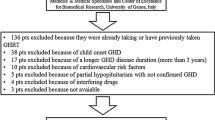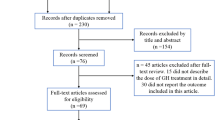Abstract
Purpose
Uncertainties exist about the predictors of the severity of the clinical picture of GH deficiency (GHD) syndrome. Aim of the study was to evaluate, in adult patients with GHD, the predictors of the development of hypercholesterolemia, hypertension, diabetes mellitus, and osteoporosis.
Methods
We retrospectively studied 327 adult patients (age 47.1 ± 17.1 years) with untreated severe GHD (mean follow-up 110.9 ± 56.8 months). GHD was defined by GHRH + arginine test using BMI cut-offs. The possible development of hypercholesterolemia, hypertension, diabetes mellitus, and osteoporosis was investigated by Kaplan–Meier survival analysis. For each clinical outcome, either a univariate or multivariate analysis according to the Cox proportional-hazards model was performed to identify those factors that were associated with the development of the event.
Results
GH secretion parameters were not associated with the outcomes. Hypercholesterolemia was positively and negatively predicted by a BMI ≥ 30 kg/m2 (HR 2.50, p 0.00) and the dose of l-thyroxine possibly in place (HR 0.98, p 0.02), respectively. Hypertension was positively predicted by a BMI ≥ 30 kg/m2 (HR 2.64, p 0.00) and IGF-I SDS values (HR 2.26, p 0.00). Diabetes mellitus was positively predicted by hypertension (HR 11.76, p 0.01). Osteoporosis was positively and negatively predicted by hypercholesterolemia (HR 3.25, p 0.01) and hypertension (HR 0.21, p 0.00), respectively.
Conclusions
The severity of the impairment of GH secretion does not predict the development of the clinical picture of GHD syndrome: untreated adult GHD does not increase the development of metabolic risk factors in hypopituitaric patients.

Similar content being viewed by others
References
Cuneo RC, Salomon F, McGauley GA, Sönksen PH (1992) The growth hormone deficiency syndrome in adults. Clin Endocrinol (Oxf) 37:387–397
Rosén T, Bengtsson BA (1990) Premature mortality due to cardiovascular disease in hypopituitarism. Lancet 336:285–288
Svensson J, Bengtsson BA, Rosén T, Odén A, Johannsson G (2004) Malignant disease and cardiovascular morbidity in hypopituitary adults with or without growth hormone replacement therapy. J Clin Endocrinol Metab 89:3306–3312
Bülow B, Hagmar L, Mikoczy Z, Nordström CH, Erfurth EM (1997) Increased cerebrovascular mortality in patients with hypopituitarism. Clin Endocrinol (Oxf) 46:75–81
Markussis V, Beshyah SA, Fisher C, Sharp P, Nicolaides AN, Johnston DG (1992) Detection of premature atherosclerosis by high-resolution ultrasonography in symptom-free hypopituitary adults. Lancet 340:1188–1192
Abs R, Bengtsson BA, Hernberg-Stâhl E, Monson JP, Tauber JP, Wilton P, Wüster C (1999) GH replacement in 1034 growth hormone deficient hypopituitary adults: demographic and clinical characteristics, dosing and safety. Clin Endocrinol (Oxf) 50:703–713
Webb SM (2008) Measurements of quality of life in patients with growth hormone deficiency. J Endocrinol Invest 31(9 Suppl):52–55
Molitch ME, Clemmons DR, Malozowski S, Merriam GR, Vance ML, Endocrine Society (2011) Evaluation and treatment of adult growth hormone deficiency: an Endocrine Society clinical practice guideline. J Clin Endocrinol Metab 96:1587–1609
Giustina A, Barkan A, Chanson P, Grossman A, Hoffman A, Ghigo E, Casanueva F, Colao A, Lamberts S, Sheppard M, Melmed S, Pituitary Society; European Neuroendocrine Association (2008) Guidelines for the treatment of growth hormone excess and growth hormone deficiency in adults. J Endocrinol Invest 31:820–838
Losa M, Gatti E, Rossini A, Lanzi R (2008) Replacement therapy with growth hormone and pituitary tumor recurrence: the relevance of the problem. J Endocrinol Invest 31(9 Suppl):75–78
Brignardello E, Felicetti F, Castiglione A, Fortunati N, Matarazzo P, Biasin E, Sacerdote C, Ricardi U, Fagioli F, Corrias A, Arvat E (2015) GH replacement therapy and second neoplasms in adult survivors of childhood cancer: a retrospective study from a single institution. J Endocrinol Invest 38:171–176
Allen DB, Backeljauw P, Bidlingmaier M, Biller BM, Boguszewski M, Burman P, Butler G, Chihara K, Christiansen J, Cianfarani S et al (2016) GH safety workshop position paper: a critical appraisal of recombinant human GH therapy in children and adults. Eur J Endocrinol 174:P1–P9
Colao A, Di Somma C, Pivonello R, Loche S, Aimaretti G, Cerbone G, Faggiano A, Corneli G, Ghigo E, Lombardi G (1999) Bone loss is correlated to the severity of growth hormone deficiency in adult patients with hypopituitarism. J Clin Endocrinol Metab 84:1919–1924
Colao A, Cerbone G, Pivonello R, Aimaretti G, Loche S, Di Somma C, Faggiano A, Corneli G, Ghigo E, Lombardi G (1999) The growth hormone (GH) response to the arginine plus GH-releasing hormone test is correlated to the severity of lipid profile abnormalities in adult patients with GH deficiency. J Clin Endocrinol Metab 84:1277–1282
Colao A, Cuocolo A, Di Somma C, Cerbone G, Della Morte AM, Nicolai E, Lucci R, Salvatore M, Lombardi G (1999) Impaired cardiac performance in elderly patients with growth hormone deficiency. J Clin Endocrinol Metab 84:3950–3955
Giustina A, Mazziotti G, Canalis E (2008) Growth hormone, insulin-like growth factors, and the skeleton. Endocr Rev 29:535–559
Abs R, Feldt-Rasmussen U, Mattsson AF, Monson JP, Bengtsson BA, Góth MI, Wilton P, Koltowska-Häggström M (2006) Determinants of cardiovascular risk in 2589 hypopituitary GH-deficient adults–a KIMS database analysis. Eur J Endocrinol 155:79–90
Aimaretti G, Baffoni C, Bellone S, Di Vito L, Corneli G, Arvat E, Benso L, Camanni F, Ghigo E (2000) Retesting young adults with childhood-onset growth hormone (GH) deficiency with GH-releasing-hormone-plus-arginine test. J Clin Endocrinol Metab 85:3693–3699
Attanasio AF, Lamberts SW, Matranga AM, Birkett MA, Bates PC, Valk NK, Hilsted J, Bengtsson BA, Strasburger CJ (1997) Adult growth hormone (GH)-deficient patients demonstrate heterogeneity between childhood onset and adult onset before and during human GH treatment. Adult Growth Hormone Deficiency Study Group. J Clin Endocrinol Metab 82:82–88
Amato G, Carella C, Fazio S, La Montagna G, Cittadini A, Sabatini D, Marciano-Mone C, Saccá L, Bellastella A (1993) Body composition, bone metabolism, and heart structure and function in growth hormone (GH)-deficient adults before and after GH replacement therapy at low doses. J Clin Endocrinol Metab 77:1671–1676
Johansson AG, Burman P, Westermark K, Ljunghall S (1992) The bone mineral density in acquired growth hormone deficiency correlates with circulating levels of insulin-like growth factor I. J Intern Med 232:447–452
Bing-You RG, Denis MC, Rosen CJ (1993) Low bone mineral density in adults with previous hypothalamic-pituitary tumors: correlations with serum growth hormone responses to GH-releasing hormone, insulin-like growth factor I, and IGF binding protein 3. Calcif Tissue Int 52:183–187
Aimaretti G, Boschetti M, Corneli G, Gasco V, Valle D, Borsotti M, Rossi A, Barreca A, Fazzuoli L, Ferone D, Ghigo E, Minuto F (2008) Normal age-dependent values of serum insulin growth factor-I: results from a healthy Italian population. J Endocrinol Invest 31:445–459
Abs R, Mattsson AF, Bengtsson BA, Feldt-Rasmussen U, Góth MI, Koltowska-Häggström M, Monson JP, Verhelst J, Wilton P, KIMS Study Group (2005) Isolated growth hormone (GH) deficiency in adult patients: baseline clinical characteristics and responses to GH replacement in comparison with hypopituitary patients. A sub-analysis of the KIMS database. Growth Horm IGF Res 15:349–359
Carroll PV, Christ ER, Sönksen PH (2000) Growth hormone replacement in adults with growth hormone deficiency: assessment of current knowledge. Trends Endocrinol Metab 11:231–238
Rosén T, Edén S, Larson G, Wilhelmsen L, Bengtsson BA (1993) Cardiovascular risk factors in adult patients with growth hormone deficiency. Acta Endocrinol (Copenh) 129:195–200
Abdu TA, Neary R, Elhadd TA, Akber M, Clayton RN (2001) Coronary risk in growth hormone deficient hypopituitary adults: increased predicted risk is due largely to lipid profile abnormalities. Clin Endocrinol (Oxf) 55:209–216
Colao A, di Somma C, Pivonello R, Cuocolo A, Spinelli L, Bonaduce D, Salvatore M, Lombardi G (2002) The cardiovascular risk of adult GH deficiency (GHD) improved after GH replacement and worsened in untreated GHD: a 12-month prospective study. J Clin Endocrinol Metab 87:1088–1093
Abs R, Mattsson AF, Thunander M, Verhelst J, Góth MI, Wilton P, Kołtowska-Häggström M, Luger A (2013) Prevalence of diabetes mellitus in 6050 hypopituitary patients with adult-onset GH deficiency before GH replacement: a KIMS analysis. Eur J Endocrinol 168:297–305
Verhelst J, Mattsson AF, Luger A, Thunander M, Góth MI, Koltowska-Häggström M, Abs R (2011) Prevalence and characteristics of the metabolic syndrome in 2479 hypopituitary patients with adult-onset GH deficiency before GH replacement: a KIMS analysis. Eur J Endocrinol 165:881–889
Mazziotti G, Doga M, Frara S, Maffezzoni F, Porcelli T, Cerri L, Maroldi R, Giustina A (2016) Incidence of morphometric vertebral fractures in adult patients with growth hormone deficiency. Endocrine 52:103–110
Hopstock LA, Bønaa KH, Eggen AE, Grimsgaard S, Jacobsen BK, Løchen ML, Mathiesen EB, Njølstad I, Wilsgaard T (2017) Longitudinal and secular trends in total cholesterol levels and impact of lipid-lowering drug use among Norwegian women and men born in 1905-1977 in the population-based Tromsø study 1979-2016. BMJ Open. https://doi.org/10.1136/bmjopen-2016-015001
Anderson KM, Wilson PW, Garrison RJ, Castelli WP (1987) Longitudinal and secular trends in lipoprotein cholesterol measurements in a general population sample. The Framingham Offspring Study. Atherosclerosis 68:59–66
Garg A, Simha V (2007) Update on dyslipidemia. J Clin Endocrinol Metab 92:1581–1589
Rizos CV, Elisaf MS, Liberopoulos EN (2011) Effects of thyroid dysfunction on lipid profile. Open Cardiovasc Med J 5:76–84
Peppa M, Betsi G, Dimitriadis G (2011) Lipid abnormalities and cardiometabolic risk in patients with overt and subclinical thyroid disease. J Lipids. https://doi.org/10.1155/2011/575840
Corneli G, Di Somma C, Baldelli R, Rovere S, Gasco V, Croce CG, Grottoli S, Maccario M, Colao A, Lombardi G, Ghigo E, Camanni F, Aimaretti G (2005) The cut-off limits of the GH response to GH-releasing hormone-arginine test related to body mass index. Eur J Endocrinol 153:257–264
Seravalle G, Grassi G (2017) Obesity and hypertension. Pharmacol Res 122:1–7
Samadian F, Dalili N, Jamalian A (2016) Lifestyle modifications to prevent and control hypertension. Iran J Kidney Dis 10:237–263
Cuspidi C, Tadic M, Grassi G, Mancia G (2018) Treatment of hypertension: the ESH/ESC guidelines recommendations. Pharmacol Res 128:315–321
Muscogiuri G, Sorice GP, Ajjan R, Mezza T, Pilz S, Prioletta A, Scragg R, Volpe SL, Witham MD, Giaccari A (2012) Can vitamin D deficiency cause diabetes and cardiovascular diseases? Present evidence and future perspectives. Nutr Metab Cardiovasc Dis 22:81–87
Ghosh M, Majumdar SR (2014) Antihypertensive medications, bone mineral density, and fractures: a review of old cardiac drugs that provides new insights into osteoporosis. Endocrine 46:397–405
Barzilay JI, Davis BR, Pressel SL, Ghosh A, Puttnam R, Margolis KL, Whelton PK (2017) The impact of antihypertensive medications on bone mineral density and fracture risk. Curr Cardiol Rep. https://doi.org/10.1007/s11886-017-0888-0
Author information
Authors and Affiliations
Corresponding author
Ethics declarations
Conflict of interest
On behalf of all authors, the corresponding author states that there is no conflict of interest.
Ethical approval
All procedures performed in studies involving human participants were in accordance with the ethical standards of the institutional and/or national research committee and with the 1964 Helsinki Declaration and its later amendments or comparable ethical standards.
Informed consent
Informed consent was obtained from the individual participant included in the study
Additional information
Publisher's Note
Springer Nature remains neutral with regard to jurisdictional claims in published maps and institutional affiliations.
Rights and permissions
About this article
Cite this article
Gasco, V., Roncoroni, L., Zavattaro, M. et al. Untreated adult GH deficiency is not associated with the development of metabolic risk factors: a long-term observational study. J Endocrinol Invest 43, 197–207 (2020). https://doi.org/10.1007/s40618-019-01100-y
Received:
Accepted:
Published:
Issue Date:
DOI: https://doi.org/10.1007/s40618-019-01100-y




